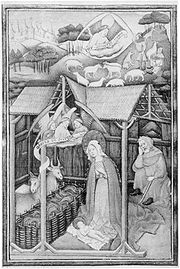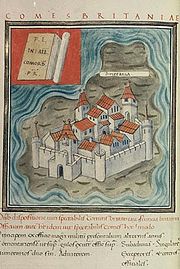
Pietro Donato
Encyclopedia

Born to a Venetian
Venice
Venice is a city in northern Italy which is renowned for the beauty of its setting, its architecture and its artworks. It is the capital of the Veneto region...
patrician
Patricianship
Patricianship, the quality of belonging to a patriciate, began in the ancient world, where cities such as Ancient Rome had a class of patrician families whose members were the only people allowed to exercise many political functions...
family, Pietro received his education at the humanist boarding school of Gasparino Barzazzi. Promoted by Biagio Pelacani, he eventually received an arts degree from the University of Padua
University of Padua
The University of Padua is a premier Italian university located in the city of Padua, Italy. The University of Padua was founded in 1222 as a school of law and was one of the most prominent universities in early modern Europe. It is among the earliest universities of the world and the second...
. He was a Thomist. As a humanist he kept a correspondence with Poggio Bracciolini.
After the death of Franciscus Zabarella, papatu dignissimus iudicatus ("adjudged worthy of the papacy"), in late September 1417 at the Council of Constance
Council of Constance
The Council of Constance is the 15th ecumenical council recognized by the Roman Catholic Church, held from 1414 to 1418. The council ended the Three-Popes Controversy, by deposing or accepting the resignation of the remaining Papal claimants and electing Pope Martin V.The Council also condemned and...
, Pietro was one of those attending who, along with Barzazzi and Pierpaolo Vergerio, composed a eulogy
Eulogy
A eulogy is a speech or writing in praise of a person or thing, especially one recently deceased or retired. Eulogies may be given as part of funeral services. However, some denominations either discourage or do not permit eulogies at services to maintain respect for traditions...
for the cardinal. Pietro and Giovanni Berardi
Giovanni Berardi
Giovanni Berardi , Italian Cardinal, of the counts of Tagliacozzo, was elected Archbishop of Taranto in 1421, and occupied the see until December 1439, when Pope Eugenius IV raised him to the cardinalate...
, Archbishop of Taranto, were co-presidents of the Council of Basel appointed by Pope Eugene IV
Pope Eugene IV
Pope Eugene IV , born Gabriele Condulmer, was pope from March 3, 1431, to his death.-Biography:He was born in Venice to a rich merchant family, a Correr on his mother's side. Condulmer entered the Order of Saint Augustine at the monastery of St. George in his native city...
. He and Berardi protested the Council after the eighteenth session (26 June 1434) re-affirmed the Haec sancta and the twenty-first session (9 June 1435) abolished the annates. On 11 August 1435 the Council officially reprimanded them, requesting that they lose their objections. Pietro later toured southern Germany in 1437. He attended the Council of Florence
Council of Florence
The Council of Florence was an Ecumenical Council of the Roman Catholic Church. It began in 1431 in Basel, Switzerland, and became known as the Council of Ferrara after its transfer to Ferrara was decreed by Pope Eugene IV, to convene in 1438...
in 1438–39 and 1442.

Illuminated manuscript
An illuminated manuscript is a manuscript in which the text is supplemented by the addition of decoration, such as decorated initials, borders and miniature illustrations...
Latin
Latin
Latin is an Italic language originally spoken in Latium and Ancient Rome. It, along with most European languages, is a descendant of the ancient Proto-Indo-European language. Although it is considered a dead language, a number of scholars and members of the Christian clergy speak it fluently, and...
Gospel book
Gospel Book
The Gospel Book, Evangelion, or Book of the Gospels is a codex or bound volume containing one or more of the four Gospels of the Christian New Testament...
, now manuscript 180 in the Pierpont Morgan Library, that was created for Donato in Padua in 1436. The chief illuminator was Johannes de Monterchio, while the frontispiece was by Peronet Lamy
Peronet Lamy
Peronet Lamy , called Perenet lenlumineur , was a Gothic painter and manuscript illuminator who spent his career in the employ of the House of Savoy....
.
Second, Pietro commissioned an illustrated copy of the Notitia Dignitatum
Notitia Dignitatum
The Notitia Dignitatum is a unique document of the Roman imperial chanceries. One of the very few surviving documents of Roman government, it details the administrative organisation of the eastern and western empires, listing several thousand offices from the imperial court down to the provincial...
in 1436; it now resides as MS Canon. Misc. 378 in the Bodleian Library
Bodleian Library
The Bodleian Library , the main research library of the University of Oxford, is one of the oldest libraries in Europe, and in Britain is second in size only to the British Library...
. The manuscript of the Notitia which Pietro had copied was one he had found in Speyer
Speyer
Speyer is a city of Rhineland-Palatinate, Germany with approximately 50,000 inhabitants. Located beside the river Rhine, Speyer is 25 km south of Ludwigshafen and Mannheim. Founded by the Romans, it is one of Germany's oldest cities...
, the Codex Spirensis earlier that year attending the council at Basel; its discovery influenced the Roma instaurata of Flavius Blondus. The work of Frontinus on the aquaeducts of Rome
Roman aqueduct
The Romans constructed numerous aqueducts to serve any large city in their empire, as well as many small towns and industrial sites. The city of Rome had the largest concentration of aqueducts, with water being supplied by eleven aqueducts constructed over a period of about 500 years...
and Vitruvius's
Vitruvius
Marcus Vitruvius Pollio was a Roman writer, architect and engineer, active in the 1st century BC. He is best known as the author of the multi-volume work De Architectura ....
De architectura
De architectura
' is a treatise on architecture written by the Roman architect Vitruvius and dedicated to his patron, the emperor Caesar Augustus, as a guide for building projects...
were preserved in very poor manuscripts until Giovanni Giocondo
Giovanni Giocondo
Friar Giovanni Giocondo, O.F.M., was an Italian friar, architect, antiquary, archaeologist, and classical scholar.-Biography:...
edited them in the 1430s, for presentation to Pietro.
As an epigraphist, Pietro compiled ancient inscriptions and collected many ancient artefacts. The Codex Hamilton, MS 254 in the Staatsbibliothek zu Berlin, was such an epigraphic collectanea. It was compiled, at least in part (folios 81–90), by Ciriaco d'Ancona, and based on one of his three visits to Athens
Athens
Athens , is the capital and largest city of Greece. Athens dominates the Attica region and is one of the world's oldest cities, as its recorded history spans around 3,400 years. Classical Athens was a powerful city-state...
(1436, 1437–8, and 1444). With the aid of a scribe and a draughtsman, Ciriaco created a portfolio of sketches of several ancient Greek
Ancient Greek
Ancient Greek is the stage of the Greek language in the periods spanning the times c. 9th–6th centuries BC, , c. 5th–4th centuries BC , and the c. 3rd century BC – 6th century AD of ancient Greece and the ancient world; being predated in the 2nd millennium BC by Mycenaean Greek...
ruins, most notably the Parthenon
Parthenon
The Parthenon is a temple on the Athenian Acropolis, Greece, dedicated to the Greek goddess Athena, whom the people of Athens considered their virgin patron. Its construction began in 447 BC when the Athenian Empire was at the height of its power. It was completed in 438 BC, although...
, for Pietro.
Pietro possessed a exemplary copy of the Chronicon
Chronicon (Eusebius)
The Chronicon or Chronicle was a work in two books by Eusebius of Caesarea. It seems to have been compiled in the early 4th century. It contained a world chronicle from Abraham until the vicennalia of Constantine I in 325 AD...
of Eusebius in Jerome's
Jerome
Saint Jerome was a Roman Christian priest, confessor, theologian and historian, and who became a Doctor of the Church. He was the son of Eusebius, of the city of Stridon, which was on the border of Dalmatia and Pannonia...
translation. He also owned 358 manuscripts of Thomas Aquinas
Thomas Aquinas
Thomas Aquinas, O.P. , also Thomas of Aquin or Aquino, was an Italian Dominican priest of the Catholic Church, and an immensely influential philosopher and theologian in the tradition of scholasticism, known as Doctor Angelicus, Doctor Communis, or Doctor Universalis...
, including the Prima pars and the Prima secundae.

Francesco Barbaro
Francesco Barbaro was an Italian politician, diplomat, and humanist from Venice, a member of the patrician Barbaro family. He is interred in the Church of the Frari, Venice.- Family :...
, Jacopo Zeno, Palla Strozzi
Palla Strozzi
Palla di Onofrio Strozzi was an Italian banker, politician, writer, philosopher and philologist.-Biography:He was born in Florence into the rich family of the Strozzi. He was educated by humanists, learning Greek and Latin, and establishing an important collection of rare books...
, and Leon Battista Alberti, may have influenced the classicism of the work of Donatello
Donatello
Donato di Niccolò di Betto Bardi , also known as Donatello, was an early Renaissance Italian artist and sculptor from Florence...
—especially his equestrian monument to Gattamelata—during his Paduan years (1444–53), when he had a studio near the Santo.
Pietro had work done on the episcopal palace during his tenure. In 1437 he contracted one Giovanni da Ulma to redecorate the chapel of San Massimo there. In 1444 Pietro commissioned Giovanni da Firenze to make the current font for the baptistry; Giovanni also repaved the interior and redid the tombs. In 1445 he comletely rebuilt the bishop's residence in a sumptuous manner.

